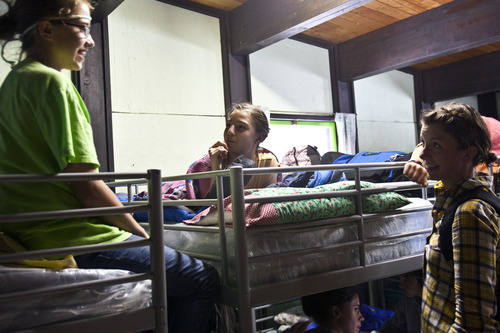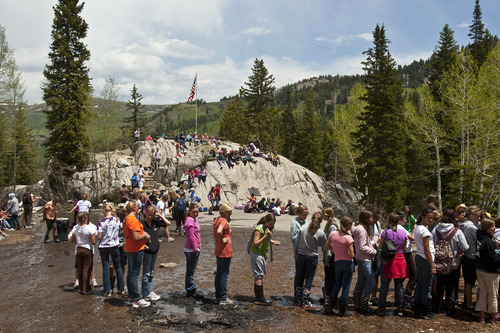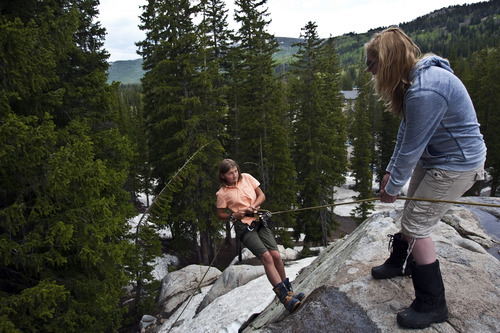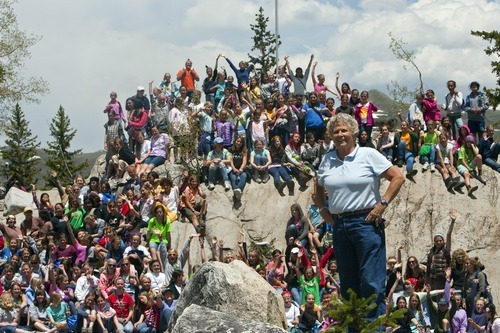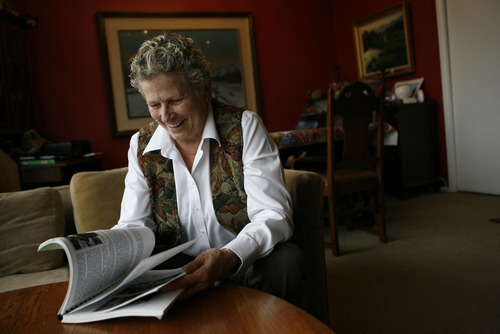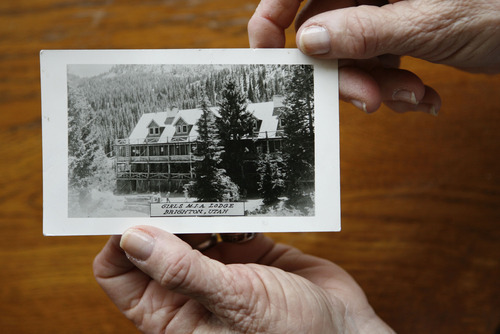This is an archived article that was published on sltrib.com in 2011, and information in the article may be outdated. It is provided only for personal research purposes and may not be reprinted.
Brighton • Snowmelt falls like heavy rain outside the open door of the Brighton LDS Girls Camp lodge office, where this year's directors — college girls — sit on a couch, nibbling chips and sandwiches and telling stories about Floss Waltman.
"Keep it clean, girls. Keep it clean," says the white-haired Waltman on this warm June day, just before the camp opened for its 90th summer season — Waltman's last after 22 years as president.
Three to 5 feet of snow still surrounds the cabins, and it continues to block the road uphill from Brighton Ski Resort's lodge.
For several hours, the camp directors — Abbi "Abu" Aird and Muriel "Yellow" Longstaff — and other staffers have been trudging uphill in softening snow from the resort parking lot, hauling in their bedding and suitcases, backpacks and Dutch ovens.
They are preparing for the first busloads of 12- to 14-year-old campers, and their boots and pants bottoms are wet. They are happy, as is Waltman, to be back in the woods at the pine-scented camp they cherish.
"There is a certain magic. I get tingles when I come up here," says Michele Nielson, whose camp nickname is "Pika."
"I feel more at home here than anywhere I've been," says Nielson, who first came as a camper at age 12, returned later as a program director and cook, and is on a committee that oversees the camp for The Church of Jesus Christ of Latter-day Saints.
Her husband, Paul D. "Pato" Nielson, got his certification so he could serve as the camp's water manager and is on an LDS priesthood committee that also has oversight.
Michele Nielson has loads of stories about Waltman, credited with rejuvenating a crumbling historic camp so that hundreds of mostly city girls could have an outdoor experience each summer.
Aird, a University of Utah student, remembers the day last summer when Waltman, now 69, lost control of a belt sander while smoothing a fallen log for the new amphitheater. It chewed up her pant leg and sanded her knee.
"There was blood, and she acted like it was no big deal," Aird says.
"That's kind of like the time she fell off the water tank," Nielson adds. "She didn't think it was any big deal."
That time, Waltman broke her finger.
Intertwined histories
Waltman doesn't want a newspaper story about her. She wants one about the camp — one that will encourage anyone ever connected to the Big Cottonwood Canyon outpost to return for its 90th birthday party at the end of July.
But those familiar with the place — including the tens of thousands of girls who have stayed there through the decades — know that Waltman and the camp are intertwined.
"There's no writing about it without talking about her," says friend Charlotte Stewart. "She just loves it with all her heart. It's one place she finds peace."
Waltman, whose given name is Sandra, has been president since 1989, but her ties to the camp go back much further.
Transplanted as a young girl from a Cache County farm to Salt Lake City, she remembers feeling out of place, the only girl in a family of boys, a tomboy in the city.
In 1955, she went to what was then called the Mutual Improvement Association Brighton Home for Girls, a camp built in 1921 by four pioneering LDS stakes in Salt Lake City.
The camp sits at the end of Big Cottonwood Canyon, essentially hidden behind a big piece of granite during the winter.
The original lodge, a frequent summer respite for LDS Church leaders such as President Heber J. Grant in its early years, burned to the ground in January 1963 after intruders made a fire inside.
Waltman was enthralled that first summer.
"I went as a 13-year-old and discovered that I could do anything I wanted if I just put my mind to it," Waltman recalls. "When I was that age, it [the focus in church meetings] was all about Joseph Smith and Brigham Young and all that. For some reason, they didn't appeal to me."
At camp, things changed. "It was the first time I felt really accepted for who I was," she says. "It was the first time I heard there was a father in heaven who loved me."
Waltman remembers going off into the woods alone — something she would never allow today — and prayed that, someday, if she was good, she could return to camp as a counselor.
Waltman did just that after her senior year in high school and for three summers during college. It was then that campers nicknamed her "Floss" for her head of bushy blond hair. The name stuck. Even her LDS temple recommend has the name Floss, rather than Sandra.
It's a Brighton tradition for campers to give the new staff and other campers nicknames, just as rooms and cabins have nicknames (nearby skunk cabbage gave the campers' restroom the name "Skunk," while the tiny bathroom allotted to the few male staffers and visitors is "Tinker Bell.")
Hands-on leader
For several decades, Waltman was rearing six children and rarely came to the camp, except to hike with her children. But Brighton came back into her life in the 1980s, and she was asked to replace Alice Edvalson as president of the committee overseeing the camp.
Edvalson credits her successor with ushering the camp into the new century.
Waltman, who went through a difficult divorce in the 1990s as well as a series of back surgeries, oversaw the installation of a modern water system and the hookup to a public sewer system. She twice painted the lodge herself and had friends make curtains and work on other upgrades.
She carved the camp's totem pole with a chain saw and added a zip line and ropes course for the girls. She defended the camp against suggestions that it be closed as one of only two LDS girls camps with a paid staff, most of them counselors. The other is Oakcrest, near Kamas, about an hour east of Salt Lake City.
Thirty-nine LDS stakes in Salt Lake Valley support the camp financially, but most Mormon girls in Utah and around the world go to other camps with women from their own wards.
In championing her camp, Waltman is "pretty feisty," Edvalson says. "She was willing to go up against the brethren to make stuff happen."
Waltman knows a number of LDS general authorities and would have none of the talk about closing the camp.
"I asked President [Thomas S.] Monson, 'How would it be if you closed down the camp and you had 80-year-old women locked arm in arm around the temple grounds?' "
She recalls Monson responding, " 'I know you would do it.' And I would."
One time, Waltman got her hackles up when the priesthood committee talked about not being able to afford camp maintenance.
"I said, 'We don't need your help,' " Waltman recalls. "They said, 'Calm down, sister, calm down.' Which I hate to be called sister."
Divisions fade away
Waltman's Brighton loyalties rest on her knowledge of what it can do for a girl to spend a week challenging herself outdoors with new friends and under the wing of a counselor.
"What I am today is because of that camp," she says, "and there are thousands that feel the same way."
Hundreds of 12-, 13- and 14-year-olds, mostly from throughout Salt Lake Valley and not all LDS, spend Monday through Friday rappelling down rocks, nursing blisters from rugged hikes and cooking in Dutch ovens over campfires. Everyone does chores.
Campers are not allowed to use cellphones and are encouraged to wear grungy clothes. Waltman wants the girls' backgrounds to fade away, so no one knows who is rich or who is poor, who comes from an intact family or who has a parent in prison.
"Sometimes, we get mean girls," Waltman says. "If they're real mean, they have to talk to me. I don't tolerate that."
With each physically and mentally demanding task — such as rock climbing or hiking to seven peaks in one day — the girls are pushed to go one step further than before.
"We like risk — in a controlled way," Waltman says. "We just want them to know anything is possible, that they can do anything they put their heart and soul and mind to."
The spiritual aspect is modeled more than taught.
"My main goals are that they learn who they are, that their father in heaven loves them and that they be kind to one another," Waltman says. "You can really get to kids if you get them in the mountains and away from all the crud."
Mandy "Dimples" Jones is a new counselor at Brighton and aims to help the girls discover the confidence she gained in three years as a camper.
"I'm hoping to get them to realize their own worth," says Jones after vacuuming out Nibik, a cabin that was buried in snow — and covered with ski tracks — this spring.
Also returning to Brighton this summer is Mickee "Poppy" Burton, who first came as a camper in 1957.
She and her husband are one of two maintenance couples.
"It's just a spiritual experience here, being in nature," says Burton, 65. "I don't remember much about being 11, but I remember every day of camp."
Waltman, who often makes the 30-minute drive from her home to camp each week in the summer, says it's time to turn over the camp to a new generation.
But she acknowledges the place may have closed had she not been in charge the past 22 years.
"I'm not a great spiritual giant, but I know how to treat people and I know what works with young girls, and that's what I'm here for."
Comeand celebrate
P Brighton LDS Girls Camp turns 90 years old this summer and will celebrate on the last weekend in July. Anyone who ever attended the camp, worked there or has ever wanted to visit can attend an open house July 30 from 10 a.m. to 6 p.m. and July 31 from noon to 6 p.m. The camp is nestled between ski runs at Brighton.



